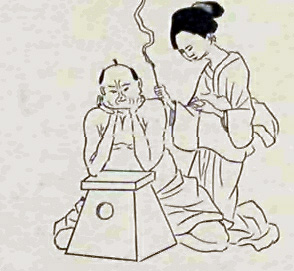“Boyd is highly knowledgeable, skilled, and is a compassionate provider. I have referred many challenging cases with positive outcomes. I recommend Boyd without reservation.”
Moxibustion
 Moxibustion is a key therapy of traditional Chinese medicine that involves the burning of an herb, Artemesia vulgaris ("mugwort"), on or near acu-points.
Moxibustion is a key therapy of traditional Chinese medicine that involves the burning of an herb, Artemesia vulgaris ("mugwort"), on or near acu-points.
Moxibustion warms and moves Qi (Energy) and so treats "Stagnation of Qi and Blood", most notably painful conditions. As a hot and dry therapy, moxa treats "Cold" and "Damp" conditions. A common example of it's use using these two combined theories would be in the case of knee osteoarthritis which is painful, stiff, and swollen and is exacerbated by cold or damp weather.
Moxa "tonifies" or enriches Qi (Energy) and specifically Yang Qi - the bright, hot, active, awake, aware, mobile, defensive Qi - and so is often used in cases of "deficiency" where there may be symptoms like fatigue, lethargy, weakness, sleepiness, feeling cold, weak digestion, declining cognitive function, low immunity, or depression.
Moxibustion has been scientifically validated in clinical trials for a number of health concerns, and studies have shed much light on the mechanisms of action, and indications for use.
At PAOM we typically utilize two very comfortable therapeutic techniques:
- Moxa Pole: a cigar shaped stick of mugwort is lit and used to gently warm specific acu-points and areas of the body. This is a great technique to warm larger areas, and to encourage proper Qi flow in the channels.
- Warming Needle: loose moxa wool is rolled into a marble-sized ball and affixed to the top of a (metal handled) needle and burned. The radiant heat is comforting, but the real power of this technique is in the painless cauterization stimulation of the acu-point, increasing the point's effectiveness.
More about Moxibustion & Thermal (Heat) Therapy:
Heat engenders life. Our body heat encourages circulation, cell nourishment and renewal and healthy metabolic processing. This link between heat therapy and health has been understood and applied by Chinese medicine for thousands of years. Earlier methods involved the application of heated stones to areas of pain or disease, but moxibustion, the topical use of the herb Ai Ye or mugwort, can be traced to the Shang dynasty (approx. 1500 BCE – 1100 BCE).
The nature of disease is understood within the parameters of being ‘hot’ or ‘cold’, ‘damp’ or ‘dry’, ‘moving’ or ‘stagnant’. Patterns defined as being cold, damp or stagnant are thought to cause pain and feelings of cold, sluggishness and poor tissue health. The medicinal actions of mugwort are defined as being warming, drying and moving, and are considered ideal for application to areas needing warmth and increased circulation.
Ai Ye is harvested, dried, then crushed forming a fluffy ‘floss’ or ‘wool’. This moxa floss is used either as is or rolled into cigar shaped sticks. During moxibustion, the moxa is burned and applied either directly or indirectly to the skin, over specific acupuncture points or regions of the body. The smoldering moxa wool can be shaped into cones and adhered to the tail of an acupuncture needle, or the moxa stick waved close to the skin surface to conduct heat into the tissues. The moxa floss may be burned in a special bowl or warmer, intended to heat larger areas of the body.
Direct moxa technique employs the use of a thin barrier between the burning moxa cone and the patient’s skin. With small rice grain moxa cones, the barrier may be simply an application of burn cream for safety, but often the barrier medium is chosen for its’ particular medicinal properties. Salt, ginger slices, garlic slices or oil, pepper and Fu Zi (aconite) cakes are common choices that enhance the actions of the mugwort herb. Care must be taken when direct moxa therapy is applied, and therapists utilize a variety of skin soothing creams and moxa handling utensils to maximize patient and practitioner safety.
Another form of smokeless thermal therapy is the use of infrared light. Infrared heat lamps use invisible light at the same frequency of the sun to generate heat. Infrared heat therapy is a comforting and non-invasive way to warm diffuse areas of the body. Applied to joints, it can help to increase mobility and decrease pain and stiffness. Warming areas of muscle soreness or trigger point pain with infrared heat is a great concurrent therapy with the application of warming liniments and massage.
